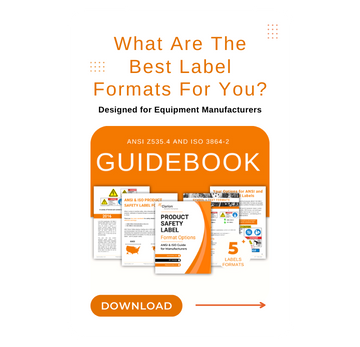

Confined Spaces Can Kill
Many workers die each year in confined spaces, overcome by the lack of oxygen or by the presence of toxic vapors that can exist in these enclosed environments. As a facility owner, your goal is to allow each of your workers to return home safely each day, even while they are accomplishing potentially hazardous work-related tasks.
How have safety signs evolved over the past 100 years? See our timeline of safety sign best practices.
ANSI/ISO Safety Signs
Clarion Safety’s confined space signs can help you to alert your workers to the existence of a confined space and the need to follow a proper permitting process before entering. Our signs use the latest ANSI Z535 formats and ISO-formatted symbols (which are accepted by OSHA) to grab your workers’ attention and convey the sign’s important message. These deter unauthorized entrances into confined spaces like manholes, silos, access shafts, sewers, tunnels, or tanks, and often prevent entrapment or engulfment caused injuries.
OSHA officially classifies an area as a confined space if it is large enough for an employee to enter fully and perform assigned work, while not being designed for continuous occupancy and having a limited or restricted means of entry or exit. Working in confined spaces can expose employees to serious health risks and hazards like loss of consciousness, air contaminant injuries, fires or explosions, oxygen deficiency, and crushing or suffocation.
What Signs Are Needed for Confined Spaces?
The OSHA regulation for confined space signs reads as follows:
1910.146(c)(2) If the workplace contains permit spaces, the employer shall inform exposed employees, by posting danger signs or by any other equally effective means, of the existence and location of and the danger posed by the permit spaces.
NOTE: A sign reading DANGER - PERMIT - REQUIRED CONFINED SPACE, DO NOT ENTER or using other similar language would satisfy the requirement for a sign.
Permit required confined spaces are defined as having one or more of the following characteristics:
- Has an international configuration that could cause an entrant to be trapped or asphyxiated by inwardly converging walls or by a floor that slopes downward and tapers.
- Contains or has the potential to contain a hazardous atmosphere.
- Contains a material that can engulf someone who enters the area
- Contains any other serious safety or health hazards.
It should be noted that as of September 11, 2013, OSHA began promoting the use of the latest ANSI Z535.2 Standard for Environmental and Facility Signs by incorporating references to this standard wherever safety signs are mentioned in their 1910 (general industry) and 1926 (construction) regulations. The ANSI Z535.2-2011, soon to be updated to 2022 standard is the standard that Clarion Safety uses for all of its confined space safety signs, giving our customers the latest in warnings technology to better reduce risk and protect people.
When Are Confined Space Signs Not Needed?
OSHA's regulation for requiring confined space DANGER signs was interpreted in OSHA instruction CPL 2.100, May 5, 1995, as follows:
- Ordinarily, information about permit spaces is most effectively and economically communicated through the use of signs. Consequently, signs would be the principal method of warning under the standard. Alternative methods, such as additional training, may be used where they are truly effective in warning all employees who could reasonably be expected to enter the space. It is the employer's obligation to assure that an alternative method is at least as effective as a sign. In some cases, employers may have to provide training in addition to signs, to protect employees who do not speak English or who would have difficulty understanding or interpreting signs. (One method by which OSHA can gauge an employer's effectiveness is through random interviews of affected employees.)
- If a space has a locked entry cover or panel, or an access door that can only be opened with special tools, the use of signs may be unnecessary if the employer ensures that all affected employees are informed about such spaces and know that they are not to be opened without taking proper precautions, including temporary signs, to restrict unexpected or unknowing entry.
It’s interesting to note OSHA's sensitivity to the possibility that English word-message-only signs do not communicate to, and thus do not protect, workers who do not read or speak English. Here again, the value of using symbols is immeasurable in providing a clear safety message.
